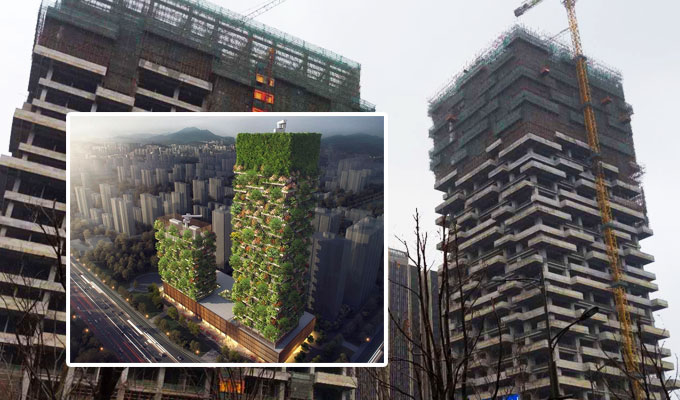A unique, for the moment, construction project in Nanjing is hoped by some to become the norm for sustainable urban development. Welcome to the Nanjing Green Towers.
An unassuming building site in a backdrop of carbon copy towers is a sight with which we are all too familiar in China. Yet, if one looks more closely at the steadily rising towers beside the Nanjing Metro at Pukou Wanhui Cheng, concrete “shelves” can be detected on the outside of the building; 21st century windowsills for the pot plants of the future.
As brainchild of renowned architect, Stefano Boeri, and eastern cousin of one existing project as well as several more in the pipeline, the Nanjing Green Towers will set a bold example as the changing face of China within the rapidly developing Yangtze River Delta economic area.
- Architect Boeri to Erect Bosco Verticale in Nanjing’s Pukou District
- Yangtze River Delta Mourns Passing of Architect I.M. Pei at 102
- In Perspective; Sifang Art Museum
Following on from the hugely popular Bosco Verticale, or “Vertical Forest” in Milan, the Nanjing Green towers will consist of two blocks, one 200m and the other, 108m, clad with trees, shrubs and perennials. The several thousand different plants will remove over 18 tonnes of CO2 from the atmosphere each year and provide around 60kg of clean oxygen each day. Boeri’s master plan of blurring the lines between nature and the urban environment is something we should all be paying more attention to. With China’s pollution epidemic showing little sign of easing up, these urban oases are a literal breath of fresh air.
China’s unprecedented economic growth in recent years means an increased strain on the environment. This, coupled with many overlooked environmental policies in the interest of maintaining a high growth rate, is leading to some catastrophic consequences, contributing to upwards of 350,000 premature deaths a year from poor quality air.
Boeri believes our cities are to blame. He mentions that cities cover just 3 percent of the earth’s surface, yet consume 75 percent of the world’s energy and contribute to 70 percent of global CO2 emissions. Many distinguished architects are recognised for perhaps only a single iconic project in their career, but Boeri’s wish is for this style of building to become the new architectural norm in the pursuit for green urban living, and for a good reason. He states that just fifteen 300-metre vertical forest buildings would have the same number of trees as that of New York City’s 3.4km2 central park.
- Feng Shui Masters; The Architecture of China’s Temples
- Top China-UK Architecture Talent Inspire Nanjing Students
- Nanjing’s Former Embassies; Reliving Republican Glamour
There is a huge benefit to planting trees in our urban environments, from reducing localised CO2 pollution levels to noticeable decreases in city temperatures by mitigation of the Urban Heat Island effect. These are critical for ensuring the immediate health of cities’ more vulnerable residents, as well as the general wellbeing of all citizens.
Owing to its size and remarkably quick response to change, China is the ideal spot for Boeri to realise his ambitious experiments. Another of his works in progress, the Liuzhou Forest City in Guanxi, is taking shape to provide sustainable housing for over 30,000 residents and curb ten times the CO2 emissions absorbed from the Nanjing project.
To consider another aspect, the striking resemblance of these buildings to the formidable karst landscape that puts Guangxi on the map is enough to grab any reader’s attention. Could you just imagine the beauty of a city fringed with the same towers as the ones we will soon see in Nanjing?











